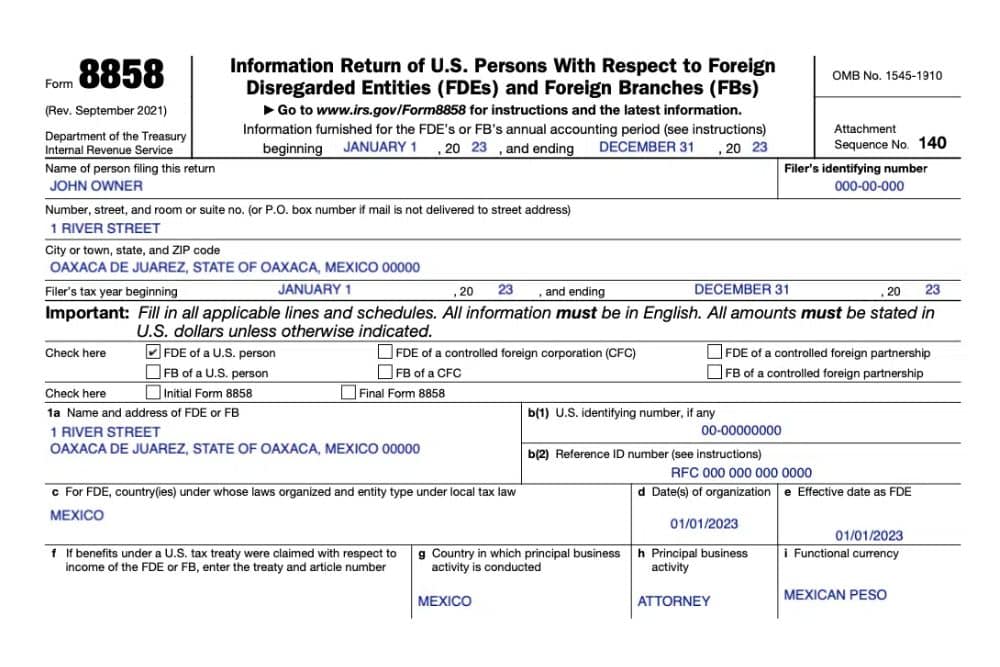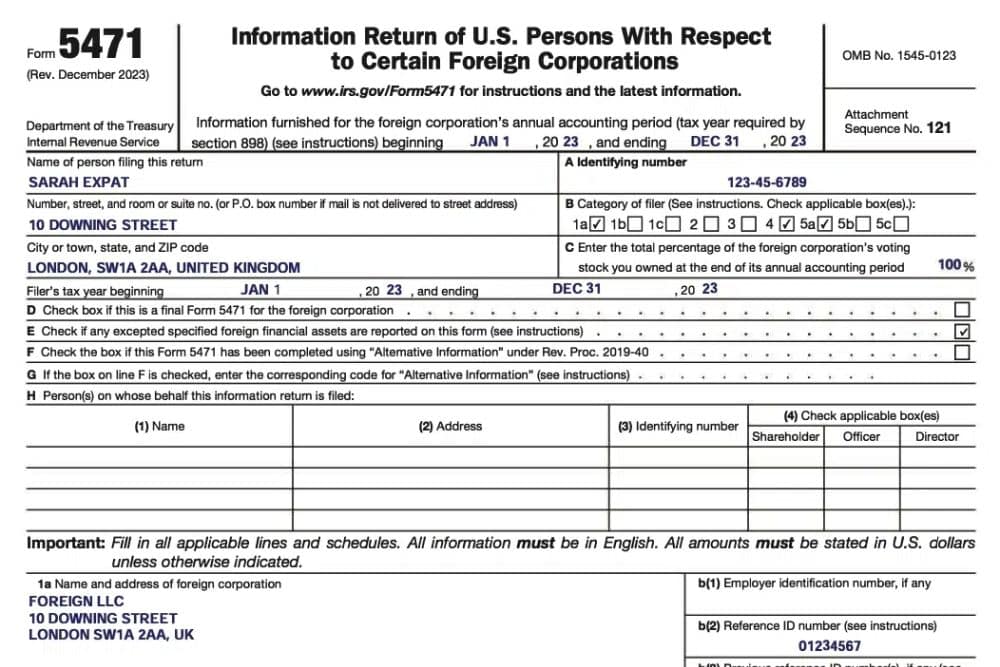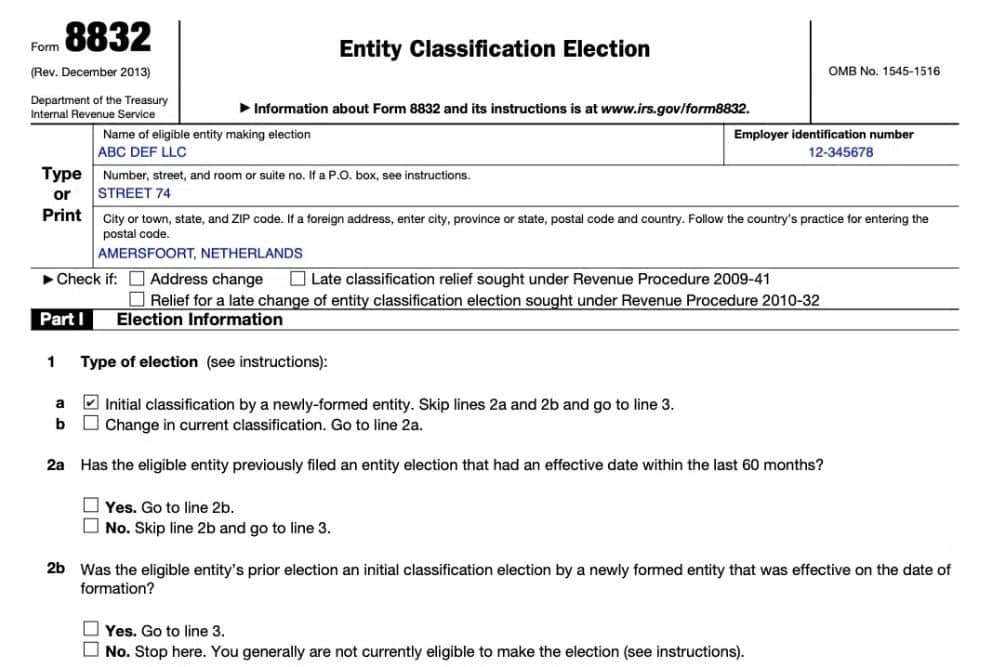All About Form 8858 and Foreign Disregarded Entities

- What Is IRS Form 8858 and How Does It Apply to Foreign Disregarded Entities?
- What Is a Foreign Disregarded Entity?
- Who Needs to File Form 8858?
- What Information Do I Need to Include on Form 8858?
- Does This Impact Self-Employment Tax?
- When Is Form 8858 Due?
- Will I Be Penalized for Failing to File Form 8858?
- How Do I File Form 8858?
- What Should I Do if I Need to File but Have Not?
- Still Have Questions about Form 8858? Get the Help You Need for Your Expat Taxes
Expat taxes can be complicated on their own, but owning a business adds an extra layer of difficulty. When a company is created and registered outside of the US, there are additional tax reporting requirements many people aren’t aware of. Not meeting these requirements can result in substantial penalties.
When a corporation is created outside the US, Form 5471 may be required. For companies created outside the US as multiple-owner, non-corporate companies, Form 8865 for foreign partnerships may be required. The most common type of company created outside the US is a single-owner, non-corporate company, and this results in having to file Form 8858 for a Foreign Disregarded Entity (FDE). Not filing these forms when required and result in substantial penalties.
In this guide, we’ll look at important questions such as: What is Form 8858? What is a foreign disregarded entity? Do I have to file Form 8858—and if so, how?
Key Takeaways
- The US Person’s Information Return for Foreign Disregarded Entity is an informational tax form that certain US taxpayers must file if they own a foreign disregarded entity. It only provides additional information to the IRS and will not increase the tax owed.
- A foreign disregarded entity is any non-US business entity that is disregarded for tax purposes. In this case, “disregarded” means the business is not taxed. Instead, all the income and other tax items are included on the owners’ tax returns.
What Is IRS Form 8858 and How Does It Apply to Foreign Disregarded Entities?
Form 8858: Information Return of US Persons with Respect to Foreign Disregarded Entities is an informational tax form that certain US taxpayers must file if they own a foreign disregarded entity. The words entity and company are used interchangeably in this article. This form only provides information to the IRS and does not result in any additional tax.

What Is a Foreign Disregarded Entity?
A foreign disregarded entity is any non-US business entity that is disregarded for tax purposes. In this case, “disregarded” means the business is not taxed, but, instead, any income the business receives is treated as the personal income of the owner. The owner of a foreign disregarded entity is responsible for all taxes on the business.
The owner reports that income on their personal income tax return is taxed at their ordinary tax rate. This is in contrast to a corporation which is a separate legal entity taxed on its income. The owners of a corporation are only taxed when they receive a dividend from the corporation or sell their shares in the corporation.
A sole proprietorship is when a person operates a business without formally creating a company. Sole proprietorships and disregarded entities are taxed in the same way. However, unlike a sole proprietorship, a disregarded entity is still recognized as a separate entity, distinct from the owner. This limits the liability of the owner.
Many entrepreneurs see disregarded entities as the best of both worlds between sole proprietorships and corporations.
Who Needs to File Form 8858?
You will need to file Form 8858 if you are the owner of a foreign entity that is considered a disregarded entity for US income tax purposes. To elect to classify your business as a disregarded entity, you will want to complete Form 8832: Entity Classification Election and file this with the IRS. Filing this form, known as the “check the box election,” confirms your choice to be treated as a disregarded entity. This is normally done to ensure your company is not treated as a foreign corporation, which could result in having to file the even more complex Form 5471.
Next, you will need to obtain an Employer Identification Number (EIN) for your foreign entity. The process is simple: call the IRS at +1-267-941-1099, and you will receive an EIN immediately over the phone.
Tax Owner vs. Direct Owner of an FDE
For filing purposes, there are two types of FDE owners: tax owners and direct owners.
- A tax owner is someone who is considered the owner of the FDE’s assets and liabilities for tax purposes.
- A direct owner is the true legal owner of the FDE.
The IRS created these two categories of ownership as a way to prevent any loopholes that might allow owners to escape having to file Form 8858.
What Information Do I Need to Include on Form 8858?
Along with your personal details (name, address, SSN, etc.) and the identifying information of your disregarded entity, including your newly obtained EIN, you will need to include the company’s financial information. For example, you will want to have profit and loss numbers handy as well as balance sheet details.
Does This Impact Self-Employment Tax?
Potentially, yes. While the foreign entity will be considered a disregarded entity for income tax purposes, the income will flow through to Schedule C of your Form 1040, so you may have to pay self-employment tax on any profits you earn. The good news, however, is that if you are living in a country that has a totalization agreement in place with the USA, the odds of paying self-employment tax are slim.
When Is Form 8858 Due?
Form 8858 is due at the same time as your federal tax return. In most cases, that would be April 15th, 2024. However, all expats receive an automatic two-month filing extension, usually moving the filing deadline to June 15. This extension applies to Form 8858 as well as your federal tax return. The same is true if you request a further extension to October.
Will I Be Penalized for Failing to File Form 8858?
Yes, as with most IRS international forms, the penalties for failure to file can be quite severe, ranging from financial to criminal penalties.
- Penalties can easily reach $60,000 or more. Penalties start at $10,000 per year per company when Form 8858 is not filed when required. If the IRS sends a notice that this form needs to be filed, additional penalties of $10,000 per month for up to 5 months can also be assessed.
- One of the main benefits of operating a business overseas is that you can generally use the income tax you pay to a foreign country to reduce any US tax owed through the use of the foreign tax credit (FTC). For not filing Form 8858 when required, 10% of any FTC benefit is lost as a penalty. This percentage can also increase if you fail to file Form 8858 after the IRS sends a notification that it is required.
- In certain cases, criminal penalties may apply.
Instructions refer to CFCs and CFPs, but the actual status applies to “any foreign business entity.” An ambiguity in the instructions does not mean that the actual law will not apply, but it can be used as a Reasonable Cause for not filing properly. Single Member foreign LLCs must file 8865 and can be assessed $10,000 for not doing so.
How Do I File Form 8858?
To complete Form 8858, you must fill out the required information on the form itself as well as Schedule M, which is a separate form. You must also attach an organization chart of the company and include certain information as specified by the IRS. Then, attach Schedule M and the organization chart to your Form 8858 and file these three items with your federal income tax return. For more detailed information, see the instructions for Form 8858 provided by the IRS.
Form 8858 is a remarkably complex tax form. It is recommended that you consult a qualified tax professional rather than attempting to complete it on your own.
For example, Form 8858 has been prepared below based on the following facts. John, a lawyer from Vermont, moved to Mexico on January 1, 2021. That same day he created the equivalent of a Limited Liability Company, or LLC, for his legal consulting services in the city of Oaxaca, Mexico. During the year, the Mexican Peso exchange rate to the US Dollar was 20.0000. For his services, he earned the US equivalent of $100,000 and received $1,000 in interest from his local Mexican bank account. Expenses totaled $51,000, giving him a profit of $50,000 before tax. Mexican income tax of $16,500 was paid on these profits, which resulted in a net income of $33,500. On the last day of the year, he owed a publisher $500 for legal books. He also bought furniture costing $10,000 for an office he was going to open sometime near the end of February 2022.
The first section of Form 8858 shows identifying information, including his name, address, company’s EIN number issued by the IRS, the country in which his company was created, and the date it was created.

Schedule C of Form 8858 is his income statement, which is also commonly called a profit and loss statement. It summarizes all his income and expenses in his functional currency or the currency he mainly uses for his business which is the Mexican Peso. It then converts all amounts to US dollars at the 20.0000 exchange rate.

Schedule F is the abbreviated balance sheet. It lists everything the company owns (its assets), all its debt (its liabilities), and the amount of equity the owners have in the company (owner’s equity). Since John started this business on January 1, 2021, all beginning balances in column a are listed as $0. The ending balances in column b show that there was $23,500 in cash in the bank account, which is the amount of profit he earned after $33,500 tax minus the $10,000 he paid for the furniture. It also shows that his liabilities are $500 for the amount he owes a publisher. The difference between his total assets of $33,500 and his debt of $500 equals the total equity he currently has in his firm of $33,000.

Schedule J shows the amount of income tax he paid to Mexico. This is important because, through the foreign tax credit or FTC, the amount of income tax paid to a foreign country can generally be used to reduce any US tax owed.
In total, he paid $16,500 in Mexican income tax. His income before tax totaled $50,000. His interest income of $1,000 is 2% of his entire income. Therefore 2% of the tax of $16,500, or $330, was the tax paid for interest. This amount is reported under column g (passive) as interest income is reported under this category for the FTC.
His income from legal fees totaled $49,000, or 98% of his entire income. Therefore, 98% of the tax of $16,500, or $16,170, was the tax paid for his legal services. This amount is reported under column h (general) as business income is reported under this category for the FTC.

The remaining schedules of Form 8858 include schedules C-1, G, H, I, and M. For tax reporting purposes, the following schedules provide specific information:
- Schedule C-1: Details gains or losses from foreign currency exchange
- Schedule G: Covers ownership of trusts, interests in foreign partnerships, and whether the company is part of a consolidated group
- Schedule H: Displays current earnings and profits and any necessary adjustments to comply with US tax accounting requirements
- Schedule I: Requires information about asset transfers
- Schedule M: Lists transactions between the company and its owner and is usually the first schedule reviewed during an audit.
What Should I Do if I Need to File but Have Not?
If you are behind on your taxes, don’t panic. The IRS provides a tax amnesty program: Streamlined Filing Compliance Procedures. By using this program, you might be able to catch up on your tax obligations without facing any penalties. Another option (if you are up to date on your filings) would be filing amended returns to include Form 8858.
Note that for most tax returns, the statutes of limitations state that the IRS only has three years to audit you. After the three-year period, by law, it is deemed that too much time has passed to be audited. However, there are special exceptions for foreign reporting requirements, including Form 8858. The three-year status of the limitation limit does not start until three years after you have filed Form 8858. This means that the IRS has the right to audit for any past year that a Form 8858 was not filed when required, even if this was for a tax year that was decades in the past.
Still Have Questions about Form 8858? Get the Help You Need for Your Expat Taxes
We hope this guide has helped you understand Form 8858 and how it may apply to your foreign-disregarded entity. However, expat taxes are nothing, if not complex. If you still have questions, we can help.
If you’re ready to be matched with a Greenback accountant, click the get started button below. For general questions on expat taxes or working with Greenback, contact our Customer Champions.




